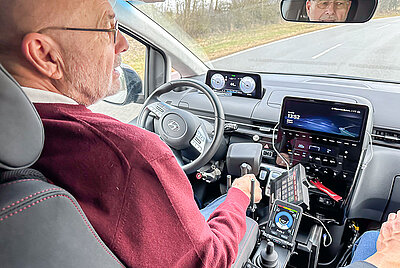Ensuring long-term mobility
Progressive disease progression and individual vehicle adaptations
People with neuromuscular diseases such as multiple sclerosis (MS), muscular dystrophies, or amyotrophic lateral sclerosis (ALS) often face the question of how to maintain their mobility for as long as possible. As the disease progresses, mobility and strength diminish, meaning that a vehicle that was originally optimally adapted will eventually no longer meet the changed requirements. Addressing this issue at an early stage helps to find appropriate solutions in time.
Joachim Glück, team leader of PARAVAN vehicle sales, advises not to wait until driving is no longer possible before taking action. "It is better to think about it earlier. If you look for a future-oriented solution in time, you can gradually get used to new operating concepts and remain independent in the long term. Wolfram and Wolfgang's examples show how individual mobility solutions can be adapted over the long term.
Wolfram: Adjustments for a secure future
Wolfram was diagnosed with IBM (inclusion body myositis), a slowly progressive muscle disease, 15 years ago. For a long time he was able to drive a conventional automatic car without any problems, but in recent years steering and braking became increasingly difficult. He noticed that his strength was diminishing and that driving required more and more concentration. Eventually, he realized he needed a future-proof solution. "My current vehicle no longer felt safe. I didn't want to wait until I couldn't drive anymore, I wanted to find a solution that would keep me mobile in the future".
After extensive consultation, he chose a Hyundai Staria with the Space Drive driving and steering system. He now controls the gas and brake pedals with his left hand using an accelerator/brake slider, while steering is done with a rotary steering system on his right hand that requires minimal effort to operate. Because his finger mobility is limited, his hands are additionally stabilized by a trident. For independent mobility outside the vehicle, he uses the Paravan PR 50 power wheelchair, which he also uses as a driver's seat. "The mobility package just has to fit. I don't just want to drive, I also want to be able to go into town or the garden independently".
Switching to the new system was unfamiliar at first. "After 50 years behind the wheel, I feel like a beginner. But I'm noticing that the interaction between the steering and the brakes is getting better and better." To further improve his safety, he has decided to take a driver safety course. His long-term goal is to drive over the Stelvio Pass. "I know it takes practice, but when I get there I will know: now I can do it!"
Wolfgang: From small customizations to custom vehicle solutions
Wolfgang also knows the challenge of adjusting to a progressive disease. The former car dealership owner was diagnosed with multiple sclerosis in 2010. While he was able to drive without major restrictions for the first few years, over time he found it increasingly difficult to operate his vehicle safely. He realized early on that he would need to modify his car in order to stay mobile. "I knew it wasn't going to be a one-time modification. I wanted to equip the vehicle gradually so that it could grow with my needs.
As a first step, he had steps installed to make it easier to get into the car. Over time, however, it became more difficult to get in, so he decided to make further modifications. Today, he uses his VW T6.1 with a cassette lift that allows him to get in with his electric wheelchair. A transfer console makes it easier for him to transfer to the driver's seat. He now controls the gas and brake pedals with a gas/brake lever and steers with the multi-function knob, which also controls the turn signals and lights.
For Wolfgang, the adaptation was a step-by-step change that can still be flexibly retrofitted. "I have been around cars all my life. I can't imagine not being able to drive one day. To me, mobility means independence. I'll drive as long as I can - just a little differently than before.
Early adjustment ensures long-term mobility
Wolfram's and Wolfgang's examples show how important it is to consider progressive illnesses in vehicle adaptation from the outset. This is not only an important safety aspect, but also crucial for long-term independence. Systems such as the Space Drive driving and steering system can also be individually adapted during use. "I often hear: I can still manage. But if you suddenly lose power, it can lead to dangerous situations. Those who get to grips with new operating concepts early on not only stay safe, but also remain independently mobile in the long term," says mobility consultant Joachim Glück.
Today, modern technologies offer a wide range of solutions - from alternative control devices for steering, accelerator, brakes or secondary functions to boarding aids. Many of these systems can be flexibly adapted and expanded to grow with individual needs. In this way, mobility is maintained even as physical needs change.







